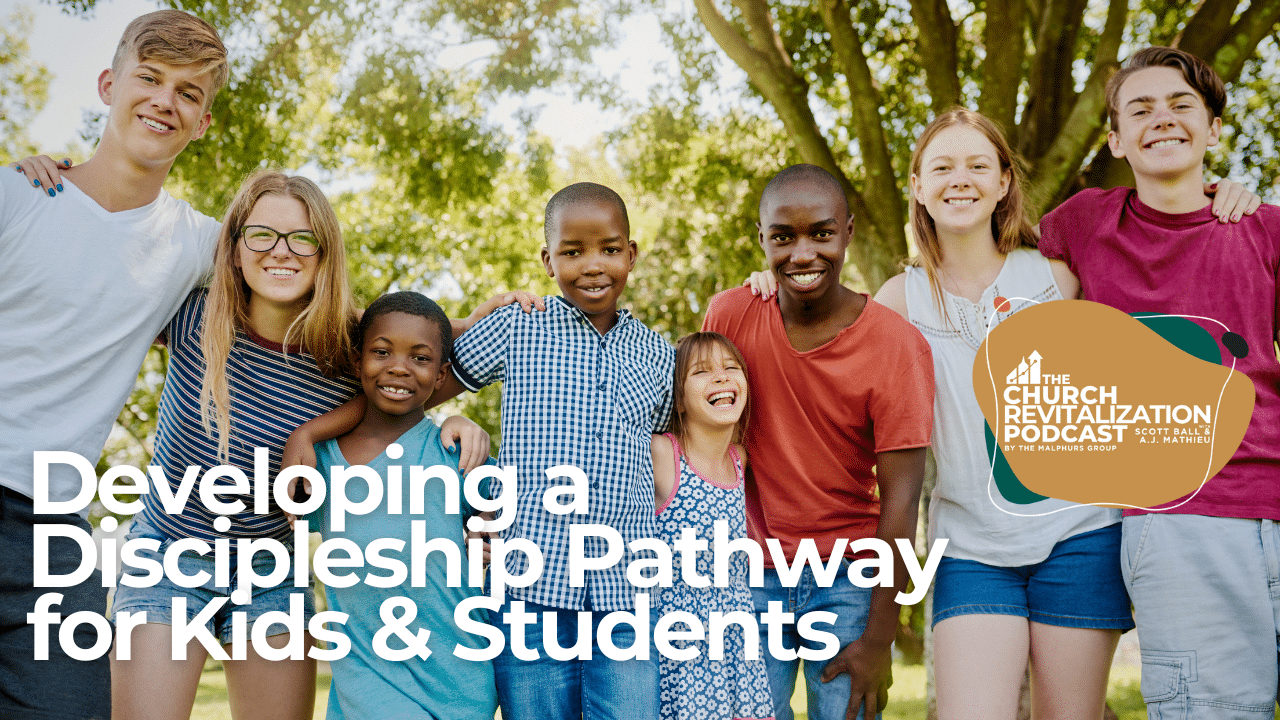The Church Revitalization Podcast – Episode 236
Discipleship is at the heart of the church’s mission, and this calling extends to every member of the congregation, regardless of age. While many churches have a well-defined discipleship pathway for adults, it is equally crucial to develop a comprehensive approach to discipleship for kids and students. The goal is not merely to provide childcare or entertainment but to intentionally guide young people on their journey of spiritual growth, helping them become mature disciples of Christ.
The discipleship of kids and students should not be viewed as a separate or isolated endeavor but rather as an integral part of the church’s overall mission. By investing in the spiritual development of young people, we lay a strong foundation for their faith and equip them to navigate life’s challenges with wisdom and resilience. Moreover, a thriving discipleship ministry for kids and students can have a profound impact on the entire church community, fostering a culture of mentorship, intergenerational relationships, and shared spiritual growth.
However, developing a discipleship pathway for kids and students requires careful planning and intentionality. It involves aligning the church’s mission, values, and discipleship steps across all age groups while making age-appropriate adjustments to ensure effective engagement and spiritual formation. In this article, we will explore some key elements for creating a robust discipleship pathway for kids and students, drawing from the principles and structure of the church’s existing adult discipleship pathway.
By following this approach, church leaders can create a unified and cohesive discipleship strategy that encompasses all ages, ensuring that every member of the congregation – from the youngest to the oldest – is supported and equipped to grow in their faith. As we embark on this journey of discipleship together, let us remember the words of Jesus in Matthew 19:14, “Let the little children come to me, and do not hinder them, for the kingdom of heaven belongs to such as these.”
Start with your existing Discipleship Pathway for adults
When developing a discipleship pathway for kids and students, it is essential to begin by examining the church’s existing discipleship pathway for adults. This adult pathway should serve as the foundation and framework for creating a cohesive, church-wide approach to discipleship.
If your church doesn’t presently have an intentional discipleship pathway, check out episode 225 for an overview of a discipleship pathway, and episode 226 for a more in depth look at primary and secondary ministries in the pathway.
Consistency in mission, definition of discipleship, and steps for discipleship across the church
At the core of the adult discipleship pathway, there should be a clear and compelling mission to make and mature disciples. This mission should be grounded in a biblical understanding of discipleship through the Great Commission and reflect the unique calling and context of the church. Additionally, the church should have a well-articulated definition of discipleship that is rooted in its values and provides a shared understanding of what it means to grow in faith and Christlikeness.
The adult discipleship pathway should also outline specific steps or stages of spiritual growth, providing a roadmap for individuals to progress in their faith journey. These steps may include practices such as engaging in worship, studying Scripture, serving others, fellowshipping with other believers, active in prayer, and sharing the gospel. By identifying these key aspects of discipleship, the church creates a common language and framework for spiritual growth that can be adapted and applied to all age groups.
Avoiding ministry silos: Ensuring all ministries align with the church’s mission, and values
One of the challenges in developing a discipleship pathway for kids and students is the tendency for individual ministries to operate in silos, disconnected from the overall mission and values of the church. To counteract this, church leaders must ensure that all ministries, including those serving young people, are aligned with the church’s overarching mission, and values.
This means resisting the temptation to create separate mission statements, or values for individual ministries. Instead, the church should strive for a unified approach to discipleship that is consistent across all age groups. By maintaining this alignment, the church can foster a sense of continuity and integration, ensuring that kids and students are being discipled in a way that is consistent with the church’s overall vision and direction.
As we move forward in developing a discipleship pathway for kids and students, it is crucial to keep these foundational principles in mind. By starting with a strong, biblically-grounded adult discipleship pathway and ensuring alignment across all ministries, the church can create a solid framework for discipling the next generation in a way that is both effective and transformative.
Apply the Pathway to Student & Kids Ministry (Sort the Ministries)
With a clear understanding of the church’s adult discipleship pathway and the importance of maintaining consistency across all ministries, the next step is to apply this pathway to the student and kids ministries. This process involves sorting existing programs and activities into the various steps or stages of the discipleship pathway.
Sorting existing ministry programs into the discipleship pathway steps
Begin by evaluating the current programs, events, and activities offered within the student and kids ministries. Consider how each of these elements contributes to the spiritual growth and development of young people. Then, map these programs onto the corresponding steps of the discipleship pathway.
For example, if the adult pathway includes steps such as “Worship,” “Grow,” “Serve,” and “Go,” consider how the existing student and kids ministry programs fit into these categories. A weekly small group Bible study might align with the “Grow” step, while a service project or outreach event could fit under the “Go” step.
By sorting the existing ministries into the discipleship pathway, church leaders can identify areas of strength and potential gaps in the spiritual formation of kids and students. This process may reveal opportunities to create new programs or modify existing ones to better align with the church’s discipleship goals.
Practical considerations when applying the pathway to younger age groups
When applying the adult discipleship pathway to student and kids ministries, it is essential to acknowledge that some programs may have elements that span multiple steps of the pathway. For example, a Vacation Bible School (VBS) program may include aspects of worship and Bible study, which align with the “Worship,” and “Grow” steps, while also serving as an outreach to new kids in the community, fitting into the “Go” step.
In cases where it is difficult to clearly place a ministry into a single step, focus on identifying the primary intention or goal of the program. While a ministry may have spillover effects into other areas, it is crucial to determine its main focus in order to optimize and enhance its effectiveness within the discipleship pathway.
By concentrating on the primary purpose of each ministry, church leaders can ensure that programs are intentionally designed to support the specific discipleship outcomes associated with each step of the pathway. This targeted approach allows for the refinement and improvement of ministries to better serve the spiritual growth and development of kids and students.
Additionally, when adapting the discipleship pathway for younger age groups, consider the learning styles, attention spans, and interests of each age group. Elementary-aged children may benefit from hands-on, interactive lessons and activities, while high school students may prefer more discussion-based and peer-led formats. Taking these factors into account will help create a more engaging and effective discipleship experience for kids and students.
As we apply the adult discipleship pathway to the younger generations, it is essential to maintain a balance between consistency and adaptability. By sorting existing programs into the pathway, focusing on their primary intention, and making necessary age-appropriate adjustments, the church can create a cohesive and effective approach to discipling kids and students, setting them on a lifelong journey of spiritual growth and transformation.
Making necessary age-appropriate adjustments to the discipleship approach
While the core principles and outcomes of discipleship remain consistent across all age groups, the way we approach discipleship with kids and students may need to be adapted to their specific developmental stages and needs. This involves tailoring our teaching methods, communication styles, and expectations to ensure that we are effectively engaging and challenging young people in their faith journey.
For younger children, this may involve using more visual and interactive teaching methods, breaking down complex biblical concepts into simpler terms, and providing opportunities for hands-on learning and exploration. As kids move into the preteen and teenage years, we may need to shift our approach to include more discussion-based learning, peer-led small groups, and opportunities for self-reflection and personal application.
It is important to set realistic expectations for spiritual development at each age level while still challenging young people to grow and stretch in their faith. This may involve adjusting the depth and complexity of the content we present, the level of personal reflection and sharing we encourage, and the types of service and outreach opportunities we offer.
By making these age-appropriate adjustments, we can create a discipleship pathway that is both developmentally appropriate and spiritually challenging for kids and students. This approach helps ensure that young people are not only growing in their knowledge of God but also developing a deep and abiding relationship with Him that will sustain them throughout their lives.
Conclusion
Developing a discipleship pathway for kids and students is a critical task for any church that seeks to fulfill the Great Commission and make disciples of all nations. By starting with a strong adult discipleship pathway, applying it to student and kids ministries, and making necessary age-appropriate adjustments, we can create a cohesive and effective approach to discipleship that engages young people at every stage of their spiritual journey.
As we embark on this process, let us keep the words of Proverbs 22:6 in mind: “Train up a child in the way he should go; even when he is old he will not depart from it.” By investing in the spiritual formation of the next generation, we are laying a foundation that will bear fruit for years to come, equipping young people to become lifelong disciples of Jesus Christ who will impact their world for His glory.
Watch this episode on YouTube!


Scott Ball is the Vice President and a Lead Guide with The Malphurs Group. He lives in East Tennessee with his wife and two children. (Email Scott).

